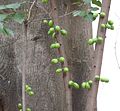bio.wikisort.org - Plant
Ficus polita, the heart-leaved fig, is a species of fig that is native to forests of tropical Africa,
| Ficus polita | |
|---|---|
 | |
| Specimen in Pretoria, South Africa | |
| Scientific classification | |
| Kingdom: | Plantae |
| Clade: | Tracheophytes |
| Clade: | Angiosperms |
| Clade: | Eudicots |
| Clade: | Rosids |
| Order: | Rosales |
| Family: | Moraceae |
| Genus: | Ficus |
| Species: | F. polita |
| Binomial name | |
| Ficus polita Vahl, 1805 | |
Distribution
The tree is found in Lowland rainforest and gallery forest (west and central Africa), coastal & dry forest (east and southern African coast), and on Madagascar. It grows up to elevations of 1,200 metres (3,900 ft).[1]
Description
Ficus polita is similar to the Pondoland fig, (Ficus bizanae), an endemic tropical forest species in South Africa. The leaves have entire margins and are often heart-shaped, with the tip acuminate.[2]
The figs are borne on old wood, in small clusters on stumpy branchlets.[2]
The pollinating wasp is Courtella bekiliensis bekiliensis (Risbec) in Madagascar, and Courtella bekiliensis bispinosa (Wiebes) on the African mainland.[1]
Gallery
- Bark texture
- Leaf shape
- Fig clusters
- Fig
References
- van Noort, Simon; Rasplus, Jean-Yves. "Ficus polita polita Vahl 1805". Figweb. Iziko Museums. Archived from the original on 2 April 2015. Retrieved 2 March 2015.
- Palmer, Eve (1977). A Field Guide to the Trees of Southern Africa. London, Johannesburg: Collins. p. 89. ISBN 0-620-05468-9.
External links
 Media related to Ficus polita at Wikimedia Commons
Media related to Ficus polita at Wikimedia Commons
Текст в блоке "Читать" взят с сайта "Википедия" и доступен по лицензии Creative Commons Attribution-ShareAlike; в отдельных случаях могут действовать дополнительные условия.
Другой контент может иметь иную лицензию. Перед использованием материалов сайта WikiSort.org внимательно изучите правила лицензирования конкретных элементов наполнения сайта.
Другой контент может иметь иную лицензию. Перед использованием материалов сайта WikiSort.org внимательно изучите правила лицензирования конкретных элементов наполнения сайта.
2019-2025
WikiSort.org - проект по пересортировке и дополнению контента Википедии
WikiSort.org - проект по пересортировке и дополнению контента Википедии



